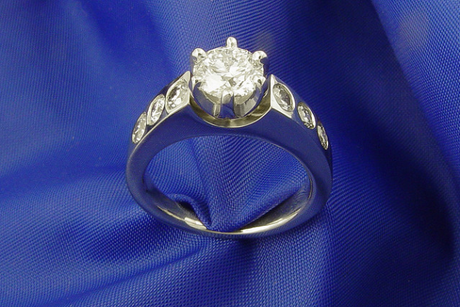Thinking about white gold? Maybe you were browsing a jewellery site, if you’re like me—and you found the white gold selection and started wondering. It looks good, but is it real gold? If you buy diamond engagement rings in Brisbane made of white gold, will you be regretting it this time next year?
Is White Gold Really Gold?
There is some confusion over whether coloured gold such as white gold are as “real” as yellow gold. The answer is yes! The difference between yellow gold and white gold is the metals used to create the alloy. 18K white gold and 18k yellow gold have the same gold content, 75%. Gold comes in quite a few alloys, actually:
- Yellow–Various mixes of gold, copper, silver, and palladium
- White–A mix of gold and at least one white metal, i.e. nickel, palladium, manganese
- Rose–A mix of gold and copper at roughly 3:1 ratio.
- Red–A mix of gold and copper at a roughly 1:1 ratio.
- Pink/Russian–Different names sometimes applied to rose and red gold.
- Spangold–A result of specially treating certain gold-copper-aluminium alloys.
- Grey–A mix of gold, silver, manganese, and copper at specific ratios
- Green–A mix of pure gold and silver, i.e. electrum.
- Purple–An alloy of gold and aluminium.
- Blue–An alloy of gold and indium.
- Black–Produced various ways: cobalt alloys, electroplating, patination, oxidation, and recently application of high-tech lasers.
As you can see, there are quite a few. This list doesn’t even cover all the possibilities! Unfortunately, not all of them work well for jewellery. Purple gold, for example, shatters easily. It’s usually used like a gem instead of as a setting. But all of them are real gold, just mixed and treated differently.
The most common versions of white gold used for jewellery are gold-palladium-silver and gold-nickel-zinc-copper alloys. One in eight people is allergic to the nickel version, so watch out for that unless you know you’re safe!

image by Mark Somma
What Can White Gold Be Used For?
White gold doesn’t have the limitations some other forms of gold do. It can be used in virtually any place traditional yellow gold could: diamond earrings, trendy accessories, and diamond engagement rings in Brisbane (or anywhere else for that matter). Pretty much any piece of fashionable jewellery you might find in yellow gold, you can find in white gold. Some pieces feature sections with two or more forms of gold for a striking contrast, a style very popular in rings.
What Is Rhodium Plating?
White gold isn’t naturally that cold silver-white you sometimes see. Real white gold has a warm golden glow to its whiteness. Some alloys even have a rose or brown tint. Not everyone is fond of that, so rhodium plating comes into play; a layer of rhodium over the top gives white gold a similar look to platinum and other white metals. This is also one way black gold is produced, except there black rhodium is used.
Putting aside the question of appearance, rhodium plating trades unmaintained longevity of maintained longevity. To clarify: Pure white gold will wear down over a long period of time. Like regular gold, it will look worse but mostly the same as it wears down. With rhodium plating, however, you’ll find the worn spots stand out much worse due to the contrast between the rhodium and the gold, especially if the maker got lazy with the gold beneath.
You’ll need to have rhodium-plated rings redipped every few years, depending on how rough you are on them. Keep up on that, and your rings will never age. But it IS an extra expense to consider.
Comparisons with Silver and Platinum
These two metals look similar to white gold, but there are definitely reasons to pick white gold. The simplest being that similar is not identical; if you like the way white gold looks better than the way silver or platinum looks, that’s reason enough right there. And there’s the intangible ‘goldness’ that white gold has.
If you’re considering durability, silver is the most damage-prone and shows age the most. Platinum’s selling point is incredible longevity and durability, although it takes a skilled metalworker to repair a piece of platinum that DOES get damaged. White gold sits in the middle, with the exact details varying with whether or not your piece has rhodium plating.
If you’re considering price, platinum is by far the most expensive option. Silver will generally run cheaper than white gold, though the gap between white gold and silver isn’t as great as the one between white gold and platinum.
Generally speaking, white gold for any kind of jewellery is rarely a bad choice. Whether it’s the best choice is up to your preferences.

